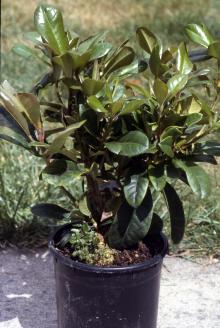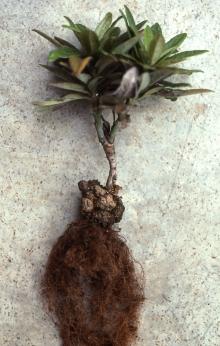Cause Unknown. A genetic change that occurs during tissue-culture propagation that predisposes plants to express symptoms when grown under accelerated growth conditions. The disease was a major problem for growers in the 1980's but with changes in production of tissue culture plants it has not been a problem for many years. Tissue proliferation has occurred on seedlings and on plants propagated by tissue culture and vegetative cutting. It is thought to be a genetic disorder that may be aggravated by some chemicals used in accelerated production (use of light-weight soilless media, high fertilizer, pesticides and growth regulators). Evidence indicates the crown gall bacterium is not involved. Field and grower observations are that the problem is not infectious and cannot be transmitted by graft. Tissue proliferation has been observed in North America as well as in Europe. Only a few rhododendron cultivars are affected, but different nurseries have trouble with different cultivars.
Symptoms Vascular tissue differentiation associated with tissue proliferation distinguishes it from wound callus and crown gall. Another characteristic is that many small shoots develop from the galled area. Crown gall is solid, looks somewhat uniform, and has malformed vascular tissue, but tissue proliferation has developed vascular connections. Tissue proliferation generally is at the plant's base but can be on shoots. It has not been seen on roots, another distinction from crown gall. The excessive tissue growth may deteriorate after several years of plant growth.
Plants appear healthy as a whole, and growth is not seriously affected. However, growers in some Eastern States have observed slow decline, wilting, and eventual death of affected plants. If tissue proliferation circles the stem of small or young plants, the plant may die due to the vascular system's disruption. Plants seem weakened at the proliferation site, so limbs on the stem may dislodge or break off easily.
This problem may be confused with witches' broom, which is characterized by several woody shoots arising from the bud near the terminal part of the plant. Gall-like growth is not associated with witches' broom.
Cultural control None known. Provide good, nonaccelerated cultural conditions for rhododendron production. Affected plants may be rogued if desired.
Reference Linderman, R.G. and Benson, D.M. 2014. Compendium of Rhododendron and Azalea Diseases and Pests, 2nd ed. St. Paul, MN:APS Press.



